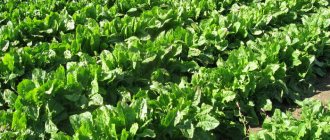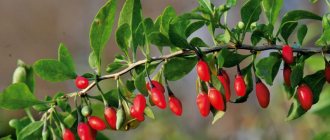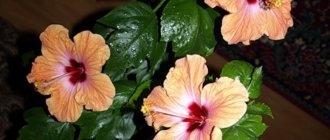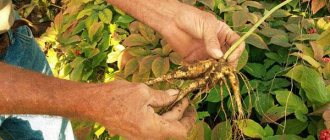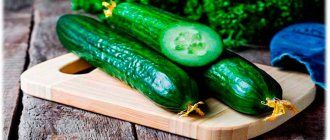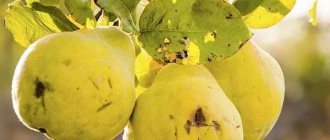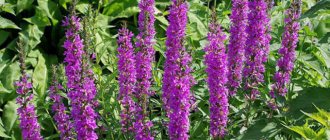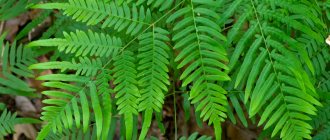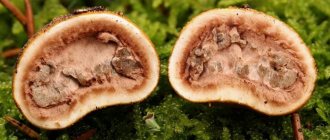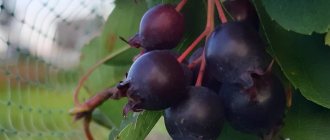What does common chicory look like?
Chicory (Petrov Knut, Blue Flower, Shcherbak) was given to humans by the Astrov family: it is a wild perennial or, if cultivated on the site, a biennial plant, which many know as a weed. The grass is easy to recognize not only by its tall, erect stems with a rough surface, sometimes reaching a height of one and a half meters, but also by its small basket-shaped inflorescences (single or in a group), most often of a bluish-gray hue, opening their petals exclusively in the cool morning hours and in cloudy weather. It should be noted that there are species with white and pink flowers . As for the description of the leaves, chicory leaves are lanceolate-ovate in shape and seem to “hug” the stems. The underground part also deserves attention - the sherbak root is very fleshy and large; by making an incision, you can see the bitter milky sap of the plant.
At the end of the growing season, roadside grass, as chicory is also called, produces fruits - three- or five-sided light brown oblong achenes.
Description
The root system is spindle-shaped and large in size. When the integrity of the root is damaged, milky sap is released.
The stem has a ribbed surface, is erect, reaching a height of up to 150 cm, forming branches. Bisexual flowers bloom in baskets, being located in the axillary space of the leaves or singly at the top of the plant. The inflorescences are blue, sometimes found in snow-white and pink colors. The petals are shaped like a tongue with five teeth. The moment of abundant flowering occurs in the middle of the summer season. At the end of flowering, chicory forms a brown achene, where the seed fruits are located.
Plant structure
The leafy part is gathered into rosettes; at the base of the garden crop, the leaves have a pitted, pinnately divided shape, narrowed towards the base. The leaves are sessile, lanceolate with a serrated margin and a voluminous base, and on the upper part the leaves have a continuous structure.
Healing chicory is a plant frequently visited by bees to collect nectar. Open inflorescences can only be found during the day, as chicory reacts positively to the sun.
Active ingredients of chicory
Folk recipes use the stems, leaves, flowers and roots of the plant. The fact is that they contain a significant proportion of inulin, a polysaccharide that helps in the fight against diabetes and metabolic problems in the body. Other beneficial substances are proteins, choline, intibin, glycosides, tannins and B vitamins such as riboflavin and thiamine. In addition, the leaves contain ascorbic acid, potassium and carotene; the juice extracted from the root contains bitters lactucin, lactucopicrin, taraxasterol, etc. Fatty oils can make up up to 30% of blue flower seeds.
Just so you know
Common chicory (Cichorium intybus)
The genus chicory (Cichorium) includes 10 species of plants. In the vast family of Asteraceae (or Asteraceae), chicory belongs to the subfamily of the same name, Chicorieaceae, or in the old way - Lettuceae, which includes 70 genera and about 2300 species. This subfamily includes such common plants as dandelion, sow thistle, kozelets (scorzonera), skerda, hawkweed, and lettuce. All flowers in chicory inflorescences are ligulate. Another characteristic of the subfamily is the presence of milky sap in plant tissues.
The most common and famous type of chicory is common chicory (Cichorium intybus L.). The range of this species is predominantly European. Outside of Europe, common chicory comes only in isolated wedges and spots.
It so happened that we have assigned chicory its official Latin name. This is despite the fact that in “pre-botanical” times this plant had more than a dozen popular names. The most common was batogs, with several options: batogs, Petrov batogs, black batogs, blue batogs. This name plays on the ability of dried plant stems to resist lodging for a long time - sometimes until spring.
In the old days, batogs were called sticks for corporal punishment. Popularly, a batog could be called either an ordinary wooden stick as thick as a finger or a short willow whip. Corporal punishment by batogami was usually inflicted on civilians. In the army, the same function was performed by spitzrutens.
Photo gallery
Growing zones
Chicory grows on loamy and sandy loamy fresh and dry soils along steep river banks, as well as on roadsides and ravine slopes. Tolerates temporary lack of moisture and significant soil compaction.
Chicory flowers have been considered medicinal since ancient times. Avicenna, a famous physician of the Middle Ages, widely used plant preparations in the treatment of a number of diseases, gastrointestinal disorders, and eye inflammation. He recommended applying chicory externally as a bandage for gout on sore joints. The plant was familiar to the ancient Romans and Greeks.
The first chicory plantations in Russia were established in 1880 in the vicinity of Yaroslavl.
Medicinal and beneficial properties of the root, herb and seeds of chicory
Thanks to the chemical composition rich in useful substances, roadside grass has a whole list of healing properties. The main ones are stimulation of digestive processes, slowing down rapid heart rates and a calming effect on the central nervous system. Shcherbak will also have a beneficial effect on the secretion of urine and bile, stop diarrhea, increase appetite, lower fever and relieve severe pain of various types. Due to such a wide spectrum of action, this herb has been valued by healers as a versatile medicine since ancient times, when herbalism occupied a prominent position in official medicine.
According to the effects produced by chicory extract on the body, the herb can be used in the fight against diseases such as diabetes, hepatitis, cholecystitis, cholangitis, gastritis, enterocolitis, stomatitis, conjunctivitis, gout, radiculitis and many others. In addition, decoctions from the root of the roadside herb are recommended for patients bitten by snakes, scorpions and lizards during the recovery period after a critical condition and the administration of an antidote.
Traditional medicine recipes often include petrov whip in preparations that help with loss of strength, incontinence, nephritis and even some skin diseases (boils, carbuncles, eczema, acne). Today this plant is recognized even in professional medical circles : preparations with chicory are prescribed as wound-healing and anti-inflammatory agents.
About the benefits of instant chicory drink for children, pregnant and lactating women
An instant drink based on crushed root benefits people of all ages. It is recommended to give the product to children only when they reach 3 years of age. Since younger generations should not consume caffeinated beverages until they are 7 years old, chicory serves as an excellent alternative.
Also read: Common chastukha: healing properties of the plant and use in folk medicine
Miracle herb is often used as a caffeine replacement. During pregnancy, a woman is recommended to drink instant chicory. Thanks to the many useful elements included in the drink, it has a complex effect on the expectant mother and baby. As a result, a pregnant woman can solve the accompanying troubles associated with pregnancy:
- relaxation of the nervous system;
- maintaining intestinal function;
- removal of bile and urinary stagnation;
- normalization of the digestive system.
Growing common chicory
Having learned about the benefits that unpretentious chicory can bring to health, not a single owner of the plot will refuse to plant it in his flowerbed. Despite the fact that this is a half-weed plant that does not require special conditions, to obtain a large and high-quality harvest of healing herbs, you need to remember a few simple rules.
Planting chicory on the site
Before planting, you need to make sure that crops such as potatoes, lettuce, carrots, tomatoes or chicory itself do not grow in the selected area - this will lead to damage to the plant by parasitic wireworms and sclerotinia and other diseases. You should also prepare for the fact that after harvesting the blue flower next year, the remains of the root will sprout , living out its life in the ground. The way out of the situation will be the subsequent settlement of this area with gladioli, tulips or irises. The location for planting roadside grass should receive enough sunlight.
The technology for planting common chicory involves several stages. Firstly, rotted manure is applied to loamy, loose and neutral soil in the fall, which after 14 days is dug up to a depth of about 0.3 m. Secondly, in the spring a complex of mineral fertilizers and ash is applied (and again dug up to a depth of 25-30 cm. ). Thirdly, in March-April, acquire seedlings, which are then planted in open ground in May. As an alternative, you can try sowing chicory with seeds, but in this case you need to remember 3-4 months - the period required for the formation of a good root crop. Seeds are sown in rows (row spacing is 20 cm), double-line ribbons or thickened planting 20x20 cm. Seedlings should be planted to a depth of no more than 2 cm. After sowing is completed, the area is rolled.
Medicinal properties of chicory (video)
Chicory care
The main procedures for caring for chicory are regular but moderate watering with warm water, deep loosening of the rows after watering and precipitation, frequent weeding (you especially need to be careful of woodlice, sow thistle and sowweed) and fertilizing with a mineral complex if necessary.
Collection and preparation of chicory
The root is used for decoctions and tinctures. It needs to be harvested in the fall: dug up, washed with cold water, dried, cut into pieces and put away to dry. The root can be dried both in the open air and in a drying chamber. Harvested raw materials are stored for no more than two years.
The tops are collected in the summer, during the flowering of roadside grass. The top 30 cm of the stem along with the inflorescences are cut and dried in the same way as the roots; It should be remembered that their shelf life is much shorter - only 1 year.
Collection
Collect roots and grass from chicory. Sometimes separate flowers, an infusion or decoction of which serve as a sedative and support for the nervous system.
Roots
The roots are collected in the fall, in the second half of September, after complete flowering. When extracting wild chicory roots, you need to pay attention to the integrity of the root shell - it should not have cavities, blackening, or signs of being eaten by pests - which is extremely rare in wild plants, so it is better to focus on collecting specially cultivated varieties.
Chicory root
The collected raw materials are washed with cool water, dried until traces of water disappear from the skin, chopped and sent to dry in a well-ventilated room or in special dryers with heating and ventilation. In the future, to prepare a coffee simulator, the pieces of root obtained after drying can be slightly fried (similar to lightly roasted coffee beans) and ground in a coffee grinder.
Roots as raw materials can be stored after collection and drying for up to 2 years.
The grass is collected at the beginning of flowering and throughout its entire duration. Cut off the tops of the chicory, approximately 25-30 cm from the top bud. The stems along with the flowers are dried in the fresh air, only in a darkened room, or in special dryers with a temperature not exceeding 60 degrees.
Dried herb can be stored for 1 year, during which time it must be used. When stored for more than a year, many beneficial properties disappear. So the optimal time for use is from season to season, during the period late autumn-spring-beginning of next summer.
Chicory plant photo
The useful plant was first grown as a fodder crop. Its roots, with a woody taste and bitterness, were used only for livestock feed. Gradually, young roots found their use in cooking and are still a delicacy in many countries.
There are many legends about chicory. It appeared in the Ottoman Empire thanks to soldiers returning from a campaign. The smell of the aromatic drink attracted the attention of Suleiman the Great and since then the healing drink began to be consumed everywhere. It is believed that the Dutch first started drinking. According to other sources, left without their favorite coffee during the blockade under Napoleon, the French began to use chicory roots. The benefits of chicory for the body, its aroma, and pleasant taste have gradually won their place on the tables of many countries.
Contraindications and side effects of common chicory
Like any medicinal plant, the roadside herb has restrictions on its use. Obviously, chicory should not be consumed if you are hypersensitive to the components. In addition, this remedy is not recommended for children under two years of age , pregnant and lactating women suffering from bronchitis and asthma, varicose veins, hemorrhoids, and obesity (increases appetite). There is virtually no evidence of overdose, but long-term use may result in diuresis. Otherwise, the components of sherbak, including the root, do not contain toxins and are completely safe.
Contraindications
Despite the wide range of beneficial properties, chicory should not be taken by nursing mothers, since the components of the drink can reduce lactation in women and have a strong stimulating effect on the nervous system of infants. In addition, the drink exhibits tonic and immunological properties, which can cause a severe allergic reaction in a baby through breast milk.
Contraindications:
- phlebeurysm;
- gastritis, ulcer;
- haemorrhoids;
- stones in the kidneys;
- gout, rheumatoid arthritis;
- vascular disorders;
- allergy to vitamin C;
- course of antibiotic treatment;
- respiratory tract diseases.
For some people, a drink made from chicory can cause overexcitation of the nervous system, insomnia, and increased appetite.
Use of the plant in other areas
Roasted plant roots are a coffee substitute. So, in Latvia they are added to our usual coffee, and a drink is also prepared from it with apple juice, honey and lemon.
Chicory flower tea is also very popular. They are often used to flavor fruit and berry drinks. The roots can serve as a source of fructose, inulin, and can be used to make alcohol (chicory yields more alcohol than potatoes, but its quality is better).
The plant is valued especially in dietary nutrition. It is actively used in the production of cakes and sweets in the food industry. Fresh leaves can be eaten; bred salad varieties contain large amounts of ascorbic acid. At the same time, salads are prepared from young stems, leaves and shoots. Young shoots are fried, boiled, baked. In Belgium, the plant is baked in wine with apples and cheese.
Witloof (leaf chicory) is grown in Europe. It is added to side dishes for steamed, fried, baked and stewed fish, to salads, and raw in soup.
During rains and humid weather, the flowers secrete a huge amount of blue nectar. From 1 hectare the plants receive up to 100 kilograms of honey.
